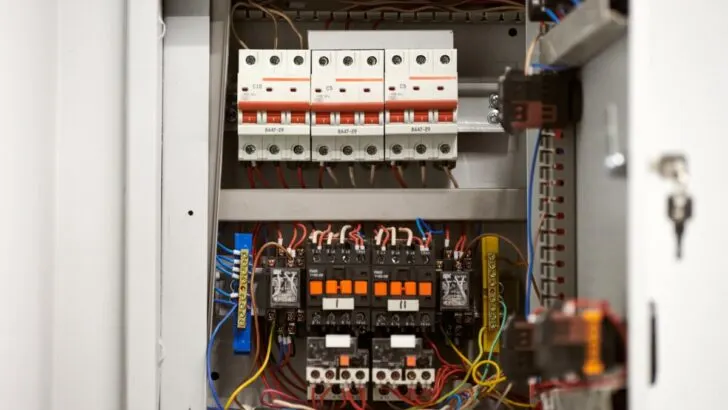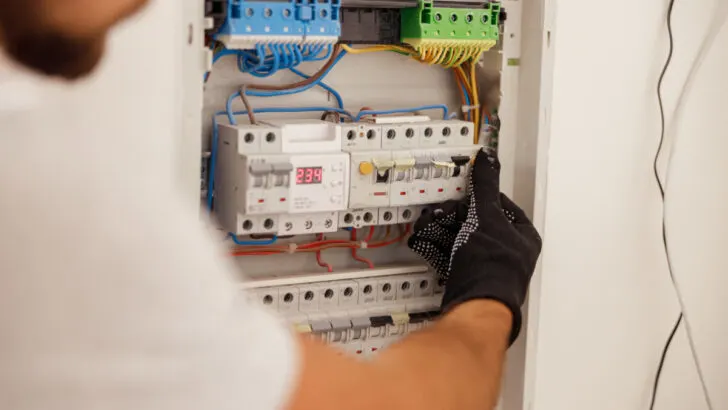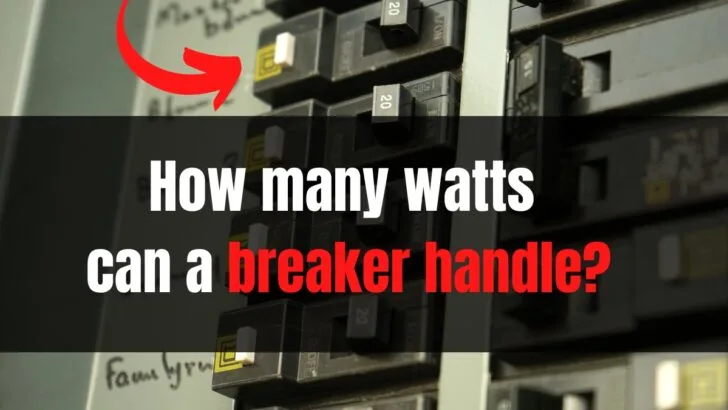The average homeowner has more things plugged in than ever before, which is why you may want to know how many watts your circuit breaker can handle.
The average breaker can handle anywhere from 1,200 to 4,800 watts. For example, a 10-amp breaker can handle 1,200 watts, a 15-amp breaker can handle 1,800 watts, a 20-amp breaker can handle 2,400 watts, and so on.
The number of watts a breaker can handle will be heavily determined by its amperage rating.
What Determines How Many Watts a Breaker Can Handle?
It’s important to understand that not all circuit breakers are made equal. Each home has different power needs, and for that reason, some people prefer to have breakers that can deliver more electricity.
With that said, the amount of watts that a breaker can handle is determined by the following factors:
- Breaker amps
- Voltage (120V or 220V)
Each breaker has a different amperage rating. This is essentially the power delivery of your circuit breaker, which is the most vital figure to keep in mind when determining how many watts it can handle.
Voltage is related to the devices and appliances that you want to connect to a circuit in your home. In the United States, the standard voltage rating is 110V for virtually all devices.
However, many other countries prefer the international standard of 220V for devices and appliances, as this has become the more popular choice abroad.
How to Calculate How Many Watts a Breaker Can Handle
Dealing with watts and amps can seem a bit intimidating at first, but once you get the formula down it’s actually very straightforward.

All you need to do is follow this formula when calculating how many watts a breaker can handle:
- Breaker amps x loaded voltage = watts a breaker can handle
For example, if you are working with a 15 amp breaker and loading it with 120V, then the maximum watts that the breaker can handle before it trips is 1,800 watts. This breaks down to 15 x 120 = 1,800.
Once you understand exactly what your circuit breaker can handle, you can use this formula to confirm the power requirements of all your devices and appliances.
With that said, you should never push your circuit breaker to its limits. Just because your breaker can handle 1,800 volts, that does not mean that you should max it out, as this can result in a power surge.
To be on the safe side, you should always leave 20% of breathing room when calculating how many watts your breaker can handle. It’s recommended that you only use 80% of your maximum circuit load, which implies that you should always multiply the amount that your breaker can handle by 0.8.
For example, for a 15 amp breaker loaded with 120V, the maximum watts for the circuit would be 1,800 watts. Take this maximum wattage number (1,800) and multiply it by 0.8 – giving you 1,440 watts. This breaks down to 15 x 120 = 1,440.
How Many Amps Does a Standard Household Need?
Unless you have customized the build of your home, chances are you have a standard breaker installed. The normal amps for standard household circuits are usually 15 or 20 amps. In most cases, this adds up to about 200 amps for an entire standard-size home.
With 15 to 20 amps at your disposal, you should be able to confidently power most household appliances and devices without overloading the breaker. However, for larger appliances, most people install 30 or even 40-amp circuits that are used to independently power energy-demanding devices.
How Many Watts Can a Breaker Handle?
A breaker can handle anywhere from 1,200 to 4,800 watts depending on its amperage rating. Each breaker has different circuits connected to it, which will determine how much it can handle.
By checking the amperage for each circuit connected to your breaker, you can identify the wattage by using the formula I mentioned above. These are the most common amps that you will find on most standard household circuit breakers:
- 10 amp breaker at 120V = 1,200 watts
- 15 amp breaker at 120V = 1,800 watts
- 20 amp breaker at 120V = 2,400 watts
- 30 amp breaker at 120V = 3,600 watts
- 40 amp breaker at 120V = 4,800 watts
The amperage rating of a breaker can greatly exceed these figures, with some going up to 70 amps. However, this is not necessary to meet the energy needs of most private homeowners, which is why most circuits are wired for 15 or 20 amps.
Remember to always multiply the maximum wattage of your breaker by 0.8 to get a safe figure for your power needs. Failure to do so can result in both minor and major power issues and safety risks.
Which Appliances Consume the Most Power?
The main reason that some breakers can handle more watts than others is that they need to power various types of devices and appliances.
Given that there are so many different types of electronic devices connected to outlets in standard homes these days, our energy consumption needs have gone up dramatically.
Small devices such as phones and tablets do not take up a considerable amount of power. On the other hand, appliances, particularly those that generate heat or cold, can consume large amounts of power, which puts strain on your breaker.
Having too many appliances connected to a single circuit can result in your breaker tripping or worse. These are common appliances that consume the most power in your home:
- Refrigerator
- Washing machine
- Microwave
- Dishwasher
- Furnace
- Electric water heater
- Air conditioners
Large appliances such as these are especially important to keep in mind when connecting to your breaker. Many of these appliances will require independent circuits and will likely require 20 or even 30 amps to meet their power needs.
What Happens When a Breaker is Overloaded?

A circuit breaker is designed to protect circuits from getting damaged due to excessive current. So long as the breaker does not have faulty components, there should not be any serious damage caused to your devices and appliances.
Breaker Trips
What is most likely to happen is that your circuit breaker trips. Once this happens, your entire home’s power supply will essentially be cut off temporarily. You need to flip the breaker back on and resolve whatever caused it to trip to get power back to your home.
Damaged Fuse
In certain situations, an overloaded breaker can cause a fuse to break. If that’s the case, you will need to replace the fuse for the breaker to function again.
Electrical Fires
Overloading a circuit can potentially result in much more serious issues such as electrical fires. This is particularly the case if the breaker did not trip, which would cause the wiring to overheat, potentially creating a fire.
One of the most common reasons for electrical fires in the United States is overloaded circuits.
Power Surge
An overloaded breaker can cause a power surge. If your outlets have surge protectors, then your devices and appliances should be safe from any kind of electrical damage.
However, if you do not have surge protectors at home, then the surge could easily fry 90% of the devices and appliances that you have connected at the time.
How to Prevent a Breaker from Overloading?
You want to avoid your breaker tripping whenever possible. Given that you can still damage property by overloading a breaker, it’s best to take preventative measures to avoid any issues.
Don’t Overload Outlets
Accidents happen and it can be easy to plug too many things into a socket and underestimate how many watts are being used.
This is the number one reason that breakers get overloaded and you can prevent it from happening simply by understanding which devices you are plugging in and how many watts they are using.
Never Exceed 80% of the Circuit Threshold
I find the best way to prevent overloads is to stick to a golden rule of keeping watt consumption below 80% of the circuit threshold.
Saving 20% of the power allowance of your circuit will ensure that you never breach the threshold and that you never have to deal with your breaking tripping.
Use Independent Circuits
If you know that you’re going to place a large energy-consuming appliance in a specific part of your home, make sure to connect it to an independent circuit.
Large appliances with more amps should always have their own independent circuits so that they don’t overload your breaker.
Key Takeaways to How Many Watts a Breaker Can Handle
The average breaker can handle 1,200 to 4,800 watts.
At 120V a 10-amp breaker can handle 1,200 watts, a 15-amp breaker can handle 1,800 watts, a 20-amp breaker can handle 2,400 watts, a 30-amp breaker can handle 3,600 watts, and a 40-amp breaker can handle 4,800 watts.
To calculate how many watts a breaker can handle, multiple breaker amps by the loaded voltage.


